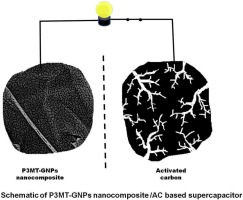当前位置:
X-MOL 学术
›
Synth. Met.
›
论文详情
Our official English website, www.x-mol.net, welcomes your feedback! (Note: you will need to create a separate account there.)
Poly(3-methyl thiophene)-graphene nanocomposites for asymmetric supercapacitors
Synthetic Metals ( IF 4.4 ) Pub Date : 2020-01-01 , DOI: 10.1016/j.synthmet.2019.116255 P. Sivaraman , Avinash P. Thakur , K. Shashidhara
Synthetic Metals ( IF 4.4 ) Pub Date : 2020-01-01 , DOI: 10.1016/j.synthmet.2019.116255 P. Sivaraman , Avinash P. Thakur , K. Shashidhara

|
Abstract Poly(3-methyl thiophene)(P3MT)–graphene nanoplatelets(GNPs) nanocomposites were investigated for the application in supercapacitors. P3MT-GNPs nanocomposites were prepared by chemical polymerization and characterised by HR-TEM, FEG-SEM, TGA, Raman spectroscopy, XRD and electrochemical methods. Nanocomposites showed a morphology in which a thin layer of P3MT coating existed over GNPs with unique open channel pattern. Electrochemical characterisation of nanocomposites carried out in 1 M tetraethylene ammonium tetrafluroborate salt (TEABF4) in propylene carbonate (PC) showed synergistic increase in specific capacitance. Nanocomposites at higher concentration of the GNPs showed higher percentage of increase in specific capacitance. The nanocomposites were used as positive electrode while activated carbon AC was used as negative electrode in an asymmetric supercapacitor. The supercapacitors were fabricated with optimized mass ratio of positive active electrode material and negative active electrode material. The P3MT-GNPs/AC supercapacitor having P3MT/GNPs wt. ratio of 75/25, in the nanocomposite exhibited a specific capacitance of 30.5 Fg−1 with respect to the total active material of the supercapacitor cell. Supercapacitors showed high rate capability and low internal resistance due to the presence of GPNs in P3MT. The stability of the supercapacitors containing nanocomposites was found to be higher than the supercapacitors containing pristine materials. The observed results are attributed to the unique morphology of the nanocomposites.
中文翻译:

用于不对称超级电容器的聚(3-甲基噻吩)-石墨烯纳米复合材料
摘要 研究了聚(3-甲基噻吩)(P3MT)-石墨烯纳米片(GNPs)纳米复合材料在超级电容器中的应用。P3MT-GNPs纳米复合材料通过化学聚合制备,并通过HR-TEM、FEG-SEM、TGA、拉曼光谱、XRD和电化学方法进行表征。纳米复合材料显示出一种形态,其中 P3MT 涂层薄层存在于 GNP 上,具有独特的开放通道图案。在碳酸亚丙酯 (PC) 中的 1 M 四亚乙基四氟硼酸铵盐 (TEABF4) 中进行的纳米复合材料的电化学表征显示出比电容的协同增加。GNP 浓度较高的纳米复合材料显示出更高的比电容增加百分比。在非对称超级电容器中,纳米复合材料用作正极,活性炭用作负极。采用优化的正极活性电极材料和负极活性电极材料的质量比制造超级电容器。P3MT-GNPs/AC 超级电容器具有 P3MT/GNPs wt。75/25 的比率,在纳米复合材料中表现出 30.5 Fg-1 的比电容,相对于超级电容器电池的总活性材料。由于 P3MT 中 GPN 的存在,超级电容器表现出高倍率能力和低内阻。发现含有纳米复合材料的超级电容器的稳定性高于含有原始材料的超级电容器。观察到的结果归因于纳米复合材料的独特形态。采用优化的正极活性电极材料和负极活性电极材料的质量比制造超级电容器。P3MT-GNPs/AC 超级电容器具有 P3MT/GNPs wt。75/25 的比率,在纳米复合材料中表现出 30.5 Fg-1 的比电容,相对于超级电容器电池的总活性材料。由于 P3MT 中 GPN 的存在,超级电容器表现出高倍率能力和低内阻。发现含有纳米复合材料的超级电容器的稳定性高于含有原始材料的超级电容器。观察到的结果归因于纳米复合材料的独特形态。采用优化的正极活性电极材料和负极活性电极材料的质量比制造超级电容器。P3MT-GNPs/AC 超级电容器具有 P3MT/GNPs wt。75/25 的比率,在纳米复合材料中表现出 30.5 Fg-1 的比电容,相对于超级电容器电池的总活性材料。由于 P3MT 中 GPN 的存在,超级电容器表现出高倍率能力和低内阻。发现含有纳米复合材料的超级电容器的稳定性高于含有原始材料的超级电容器。观察到的结果归因于纳米复合材料的独特形态。P3MT-GNPs/AC 超级电容器具有 P3MT/GNPs wt。75/25 的比率,在纳米复合材料中表现出 30.5 Fg-1 的比电容,相对于超级电容器电池的总活性材料。由于 P3MT 中 GPN 的存在,超级电容器表现出高倍率能力和低内阻。发现含有纳米复合材料的超级电容器的稳定性高于含有原始材料的超级电容器。观察到的结果归因于纳米复合材料的独特形态。P3MT-GNPs/AC 超级电容器具有 P3MT/GNPs wt。75/25 的比率,在纳米复合材料中表现出 30.5 Fg-1 的比电容,相对于超级电容器电池的总活性材料。由于 P3MT 中 GPN 的存在,超级电容器表现出高倍率能力和低内阻。发现含有纳米复合材料的超级电容器的稳定性高于含有原始材料的超级电容器。观察到的结果归因于纳米复合材料的独特形态。发现含有纳米复合材料的超级电容器的稳定性高于含有原始材料的超级电容器。观察到的结果归因于纳米复合材料的独特形态。发现含有纳米复合材料的超级电容器的稳定性高于含有原始材料的超级电容器。观察到的结果归因于纳米复合材料的独特形态。
更新日期:2020-01-01
中文翻译:

用于不对称超级电容器的聚(3-甲基噻吩)-石墨烯纳米复合材料
摘要 研究了聚(3-甲基噻吩)(P3MT)-石墨烯纳米片(GNPs)纳米复合材料在超级电容器中的应用。P3MT-GNPs纳米复合材料通过化学聚合制备,并通过HR-TEM、FEG-SEM、TGA、拉曼光谱、XRD和电化学方法进行表征。纳米复合材料显示出一种形态,其中 P3MT 涂层薄层存在于 GNP 上,具有独特的开放通道图案。在碳酸亚丙酯 (PC) 中的 1 M 四亚乙基四氟硼酸铵盐 (TEABF4) 中进行的纳米复合材料的电化学表征显示出比电容的协同增加。GNP 浓度较高的纳米复合材料显示出更高的比电容增加百分比。在非对称超级电容器中,纳米复合材料用作正极,活性炭用作负极。采用优化的正极活性电极材料和负极活性电极材料的质量比制造超级电容器。P3MT-GNPs/AC 超级电容器具有 P3MT/GNPs wt。75/25 的比率,在纳米复合材料中表现出 30.5 Fg-1 的比电容,相对于超级电容器电池的总活性材料。由于 P3MT 中 GPN 的存在,超级电容器表现出高倍率能力和低内阻。发现含有纳米复合材料的超级电容器的稳定性高于含有原始材料的超级电容器。观察到的结果归因于纳米复合材料的独特形态。采用优化的正极活性电极材料和负极活性电极材料的质量比制造超级电容器。P3MT-GNPs/AC 超级电容器具有 P3MT/GNPs wt。75/25 的比率,在纳米复合材料中表现出 30.5 Fg-1 的比电容,相对于超级电容器电池的总活性材料。由于 P3MT 中 GPN 的存在,超级电容器表现出高倍率能力和低内阻。发现含有纳米复合材料的超级电容器的稳定性高于含有原始材料的超级电容器。观察到的结果归因于纳米复合材料的独特形态。采用优化的正极活性电极材料和负极活性电极材料的质量比制造超级电容器。P3MT-GNPs/AC 超级电容器具有 P3MT/GNPs wt。75/25 的比率,在纳米复合材料中表现出 30.5 Fg-1 的比电容,相对于超级电容器电池的总活性材料。由于 P3MT 中 GPN 的存在,超级电容器表现出高倍率能力和低内阻。发现含有纳米复合材料的超级电容器的稳定性高于含有原始材料的超级电容器。观察到的结果归因于纳米复合材料的独特形态。P3MT-GNPs/AC 超级电容器具有 P3MT/GNPs wt。75/25 的比率,在纳米复合材料中表现出 30.5 Fg-1 的比电容,相对于超级电容器电池的总活性材料。由于 P3MT 中 GPN 的存在,超级电容器表现出高倍率能力和低内阻。发现含有纳米复合材料的超级电容器的稳定性高于含有原始材料的超级电容器。观察到的结果归因于纳米复合材料的独特形态。P3MT-GNPs/AC 超级电容器具有 P3MT/GNPs wt。75/25 的比率,在纳米复合材料中表现出 30.5 Fg-1 的比电容,相对于超级电容器电池的总活性材料。由于 P3MT 中 GPN 的存在,超级电容器表现出高倍率能力和低内阻。发现含有纳米复合材料的超级电容器的稳定性高于含有原始材料的超级电容器。观察到的结果归因于纳米复合材料的独特形态。发现含有纳米复合材料的超级电容器的稳定性高于含有原始材料的超级电容器。观察到的结果归因于纳米复合材料的独特形态。发现含有纳米复合材料的超级电容器的稳定性高于含有原始材料的超级电容器。观察到的结果归因于纳米复合材料的独特形态。



























 京公网安备 11010802027423号
京公网安备 11010802027423号